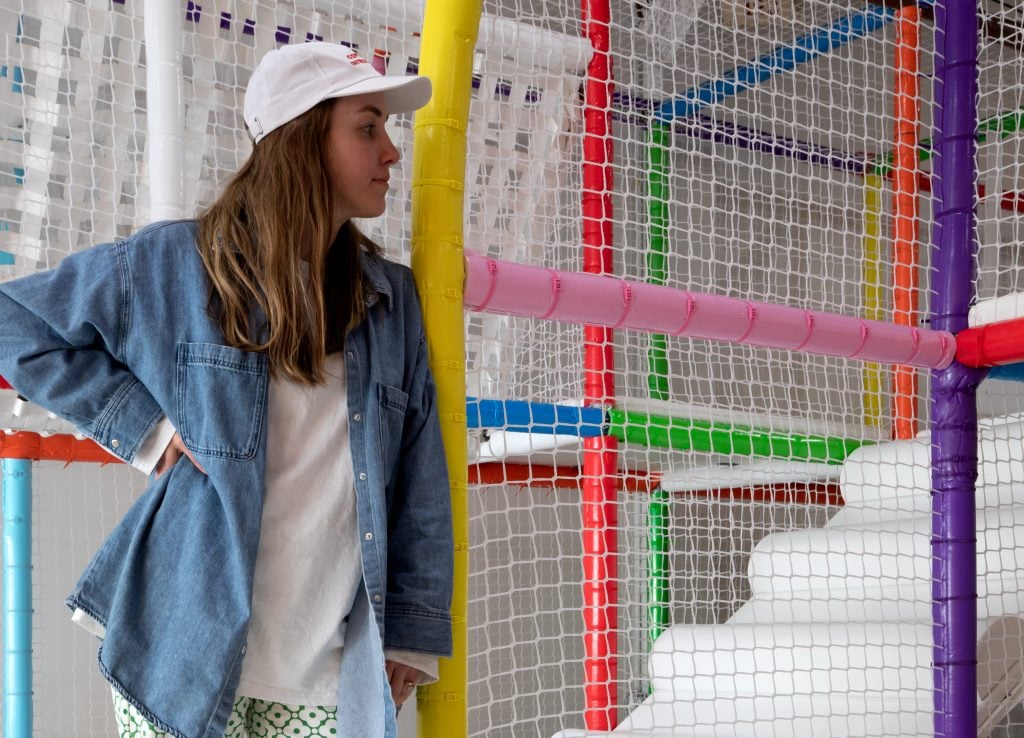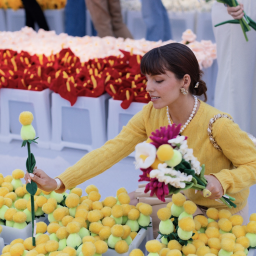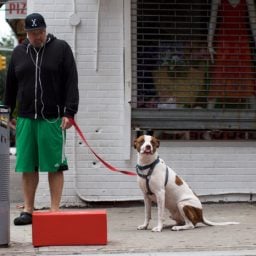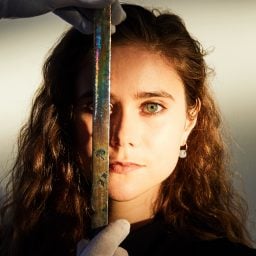Cj Hendry didn’t grow up going to Chuck E. Cheese-style indoor playgrounds, which many children of the 1980s and ’90s recall as magical realms of climbing nets, slides, and ball pits, with the next adventure always around the corner in a maze of colorful plastic tunnels perched high in the air.
“I’ve never actually been to an indoor playground before,” the artist, who has built one in a Greenpoint, Brooklyn, warehouse for her latest solo show, told Artnet News.
Hendry, who was born in Australia—where it’s called Charlie Cheese’s Pizza Playhouse, in case you’re wondering—hadn’t even taken her own young children to experience the wonder that is a ball pit yet when she conceived of the exhibition. Titled “Plaid,” the show features the artist’s latest series of hyper-realistic pencil drawings, this time imitating crisscrossed lines of colored paint that recall the titular variety of fabric.
The accompanying 5,000-square-foot “Plaidground,” as Hendry has christened it, is meant to recall the simple geometry of the drawings, with all white floors, slides, netting, and structures contrasting with colored padding on the angular armatures.
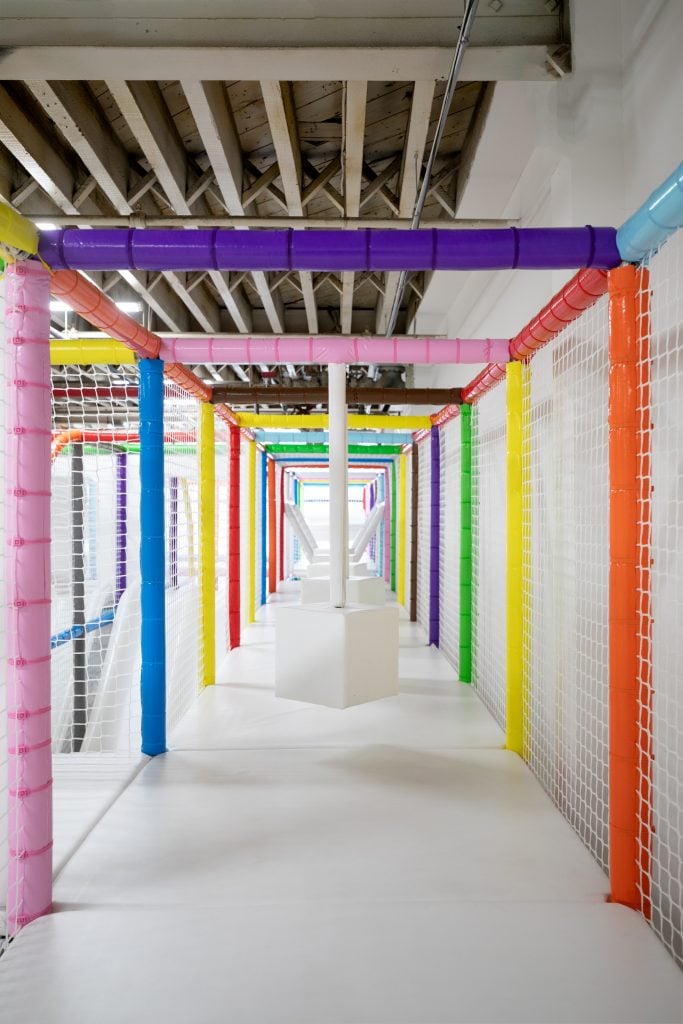
“Cj Hendry: Plaid” installation view. Photo courtesy of the artist.
Hendry worked with a playground manufacturer to bring her vision to life, designing a custom structure to fit the dimensions of the space (which previously served as her studio for three years after moving to New York in 2015). She was frustrated when the company kept suggesting adding pops of other colors, like a bright blue slide.
“We’re like, no, no, no, no, no, no, no. We want everything white apart from the beams, and they just couldn’t wrap their head around that,” Hendry recalled, explaining that she wanted a calming effect—perhaps reminiscent, she admitted, of the padded white walls of the inflatable bouncy castle of her 2019 New York show “Rorschach.”
The artist’s real dream would have been to design a permanent outdoor playground, Hendry said, but “the rigamarole of Brooklyn Parks and Rec could take years and years and years—I’m not that patient.”
The two-level indoor labyrinth Hendry erected for “Plaid” includes, among other features, trampolines, swings, and not one but two ball pits—the larger one is filled with squishy foam cubes, and has a dramatic entry by slide.
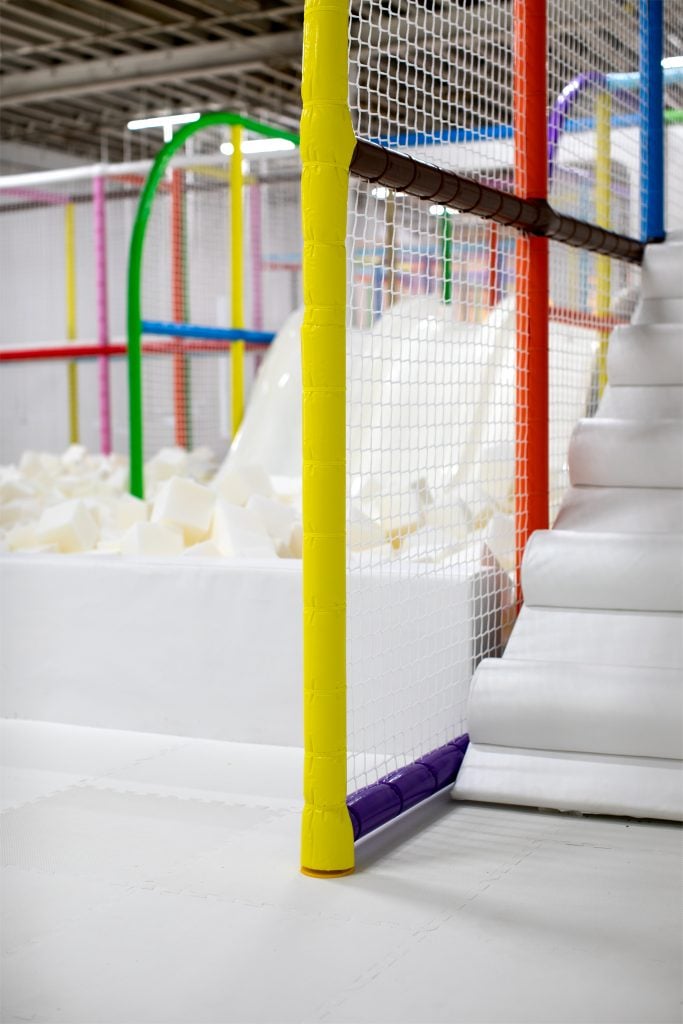
“Cj Hendry: Plaid” installation view. Photo courtesy of the artist.
Just over 24 hours ahead of the exhibition’s official unveiling, Hendry and her crew were finishing up all the last minute details on the ambitious installation, cutting the ends off of tens of thousands of zip ties securing foam padding in place and mixing up Jell-O shots for the opening reception.
Since her first New York show—at a popup Soho gallery in 2017—Hendry has embraced the trend for immersive installations, crafting elaborate settings in which to experience her drawings. There was the aforementioned bouncy castle, the brightly colored home decor theme of “Monochrome” (also in New York), and the constant streaming of falling petals in “Epilogue,” held last year in a 19th-century London church.
“The space itself was extraordinary—just jaw-droppingly stunning. And what was special was the church had been abandoned for like 50 years, and we renovated it, staged a beautiful exhibition, and brought it back to life for the community to use,” Hendry said.
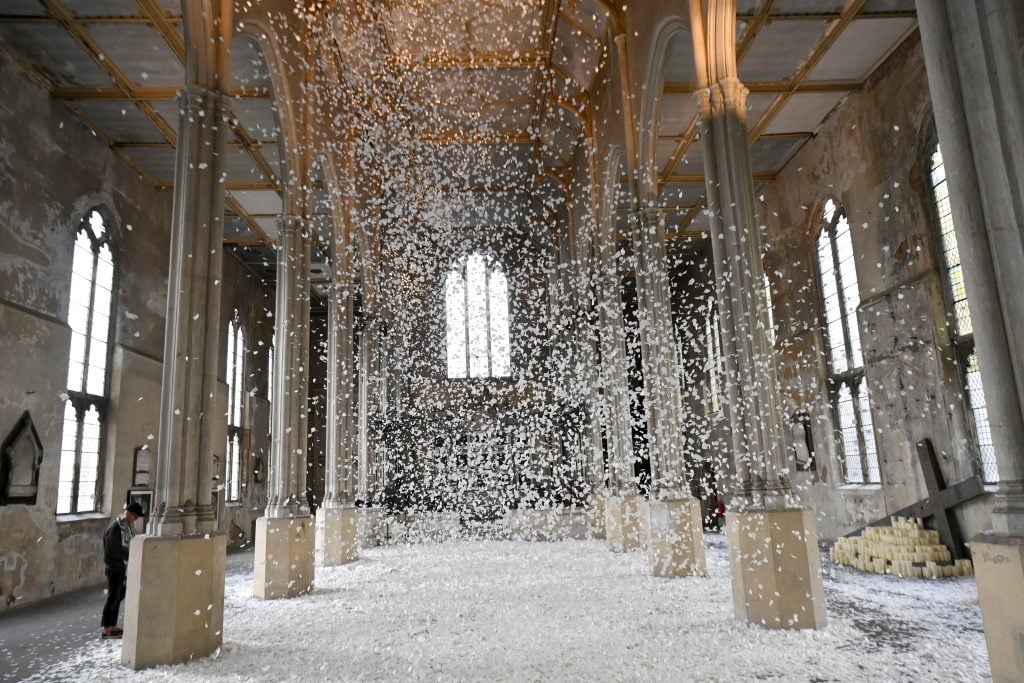
A general view of the opening of “Epilogue,” the first UK solo show from Brisbane-born, New York-based artist Cj Hendry, at the New Testament Church of God in East London. Photo by David M. Benett/Dave Benett/Getty Images for Cj Hendry.
The scale of that project was something she scarcely could have imagined back in 2012, when Hendry posted her first drawing on Instagram. She had already dropped out of architecture school, was soon to abandon the three-year finance degree program that was dragging into its fifth year. What stuck, surprisingly, was drawing, in painstaking detail, the handbags from her day job at a Chanel store.
Hendry quickly built up a following for her photorealistic drawings on Instagram, where she now has 681,000 followers. Her social media use has evolved over the last decade-plus, especially with the platform’s pivot to Reels.
“It has changed but like, you adapt to it. We just take a lot more video content,” Hendry said. “I really like making videos. I think it’s quite fun. You can tell a broader story, and there’s less place to hide behind a perfectly still image that’s edited perfectly.”
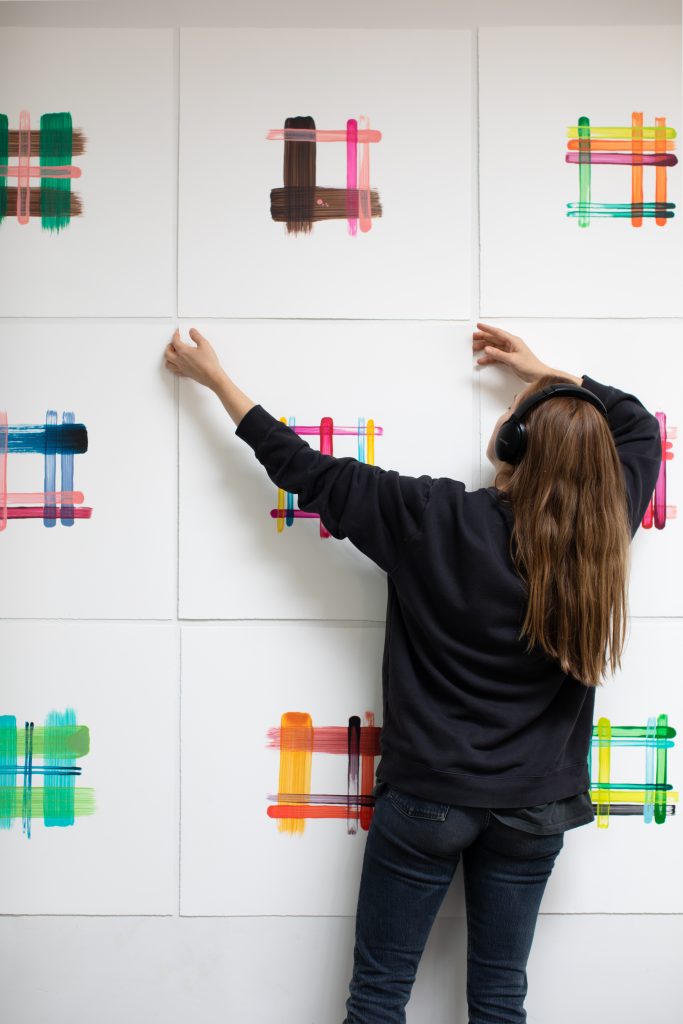
Cj Hendry installing drawings at her exhibition “Plaid.” Photo courtesy of the artist.
Another recent change has been in the artist’s personal life, as she had her first child, a son, in 2020, with a daughter following in 2022.
“I’m working probably half as much as I used to, which is difficult because I’m somewhat of a workaholic,” Hendry admitted. “They are just a complete delight and it really puts into perspective working 100-hour-plus weeks. But for what, who cares? You’re just an artist.”
Not that she still isn’t fully engaged with her craft, and dedicated to finding new directions in which to push photorealism, to continue to surprise the viewer.
“People are like, ‘you can just draw a landscape,’ but that’s of no interest to me,” Hendry said.
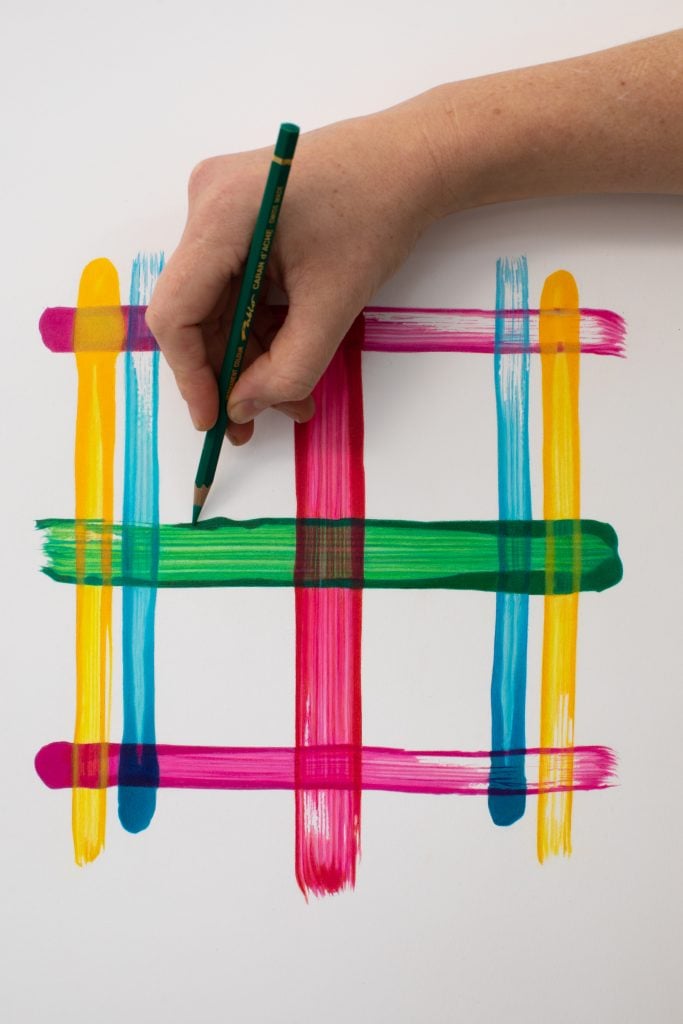
Cj Hendry completing ones of the drawings for her exhibition “Plaid.” Photo courtesy of the artist.
“Plaid” grew out of a commission from a client, who asked Hendry to create a facsimile of a Elaine de Kooning work the collector had failed to win at an auction. The artist found she loved using hyperrealism—normally used to render 3-D images—in a more 2-D realm.
“I really like that trickery in a way,” Hendry said. “It is weirdly more challenging than you think.”
The process of “Plaid,” involved painting hundreds of hashtags in different color combinations. (Those preparatory works, however, are not for sale.) The palettes Hendry deemed most successful, she translated into drawings—a process that takes hours.
“My drawing practice is really intimate. It’s beautiful, but it’s really labor intensive and it’s also really lonely,” she said. “Drawing, I’m very close to the works, physically, whereas the buildings and the concepts [for my exhibitions] are so big and other worldly that they are two completely opposite ends of the scale.”
That contrast is something that Hendry has come to crave.
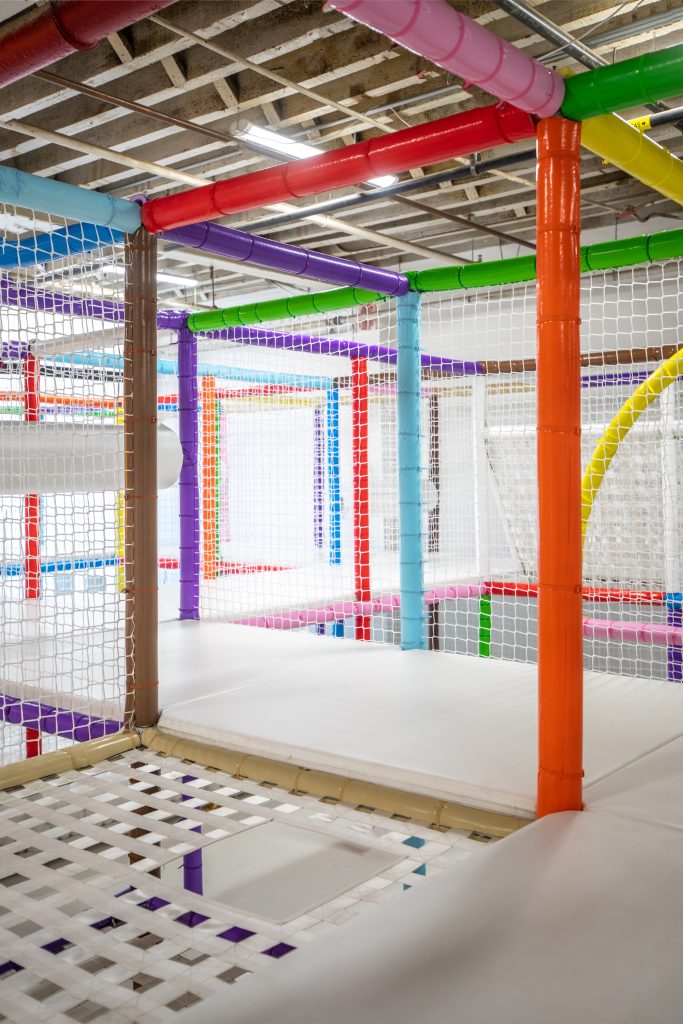
“Cj Hendry: Plaid” installation view. Photo courtesy of the artist.
“I get desperate to jump out and do these big things, because it allows me to be a little bit wild and creative,” Hendry added. “I’m thinking bigger and bigger, and in the drawings you can’t go so big, because you’re limited to your sheet of paper.”
The artist is already planning her next show, her first in Paris, which she describes as “much more intimate.” That will be some time in the fall.
Also on the horizon is Hendry’s first documentary film, Copyright Infringement, named after her interactive art scavenger hunt of the same name. It involves fans stalking her Instagram to successfully be the first to lay their hands on a t-shirt featuring her drawings of another artist’s copyrighted art, dropped in random locations without warning.
After five successful editions, Hendry is retiring the series—but plans to launch a new project in the fall.
“I think we’ll do something similar,” she said. “It will be free, completely free, but you have to put in sweat equity and go and find them, you know. You’ll have to really run for it.”
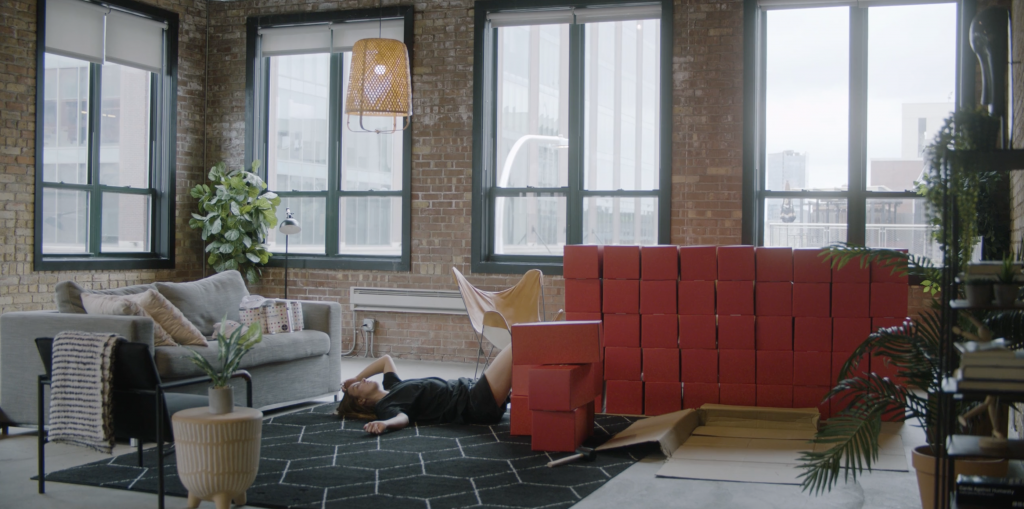
Cj Hendry in Copright Infringement after completing the assembly of 50 boxes for the drop in Chicago, Illinois. Photo courtesy of D’Marie Productions.
Part of the reason for the popularity of “Copyright Infringement” was that Hendry’s online fans can rarely afford to buy her original work—the 24 drawings in “Plaid” are priced at $19,500 and $47,500 each, depending on the size, and the majority were pre-sold. (There are also $750 lenticular prints—but instead of the illusion of a moving image as you view it from different directions, the artwork changes color.)
But it is the sale of those works that helps cover the production costs of Hendry’s exhibitions, where fans can enjoy her work in person for just $10 a piece—and bring home a free pair of plaid grippy socks to boot. (Plus, there’s a gift shop full of swag in the $100 range.)
To date, Hendry has staged 10 solo shows, all independently, without gallery representation or a museum to host—not that she’s not interested in those sort of collaborations.
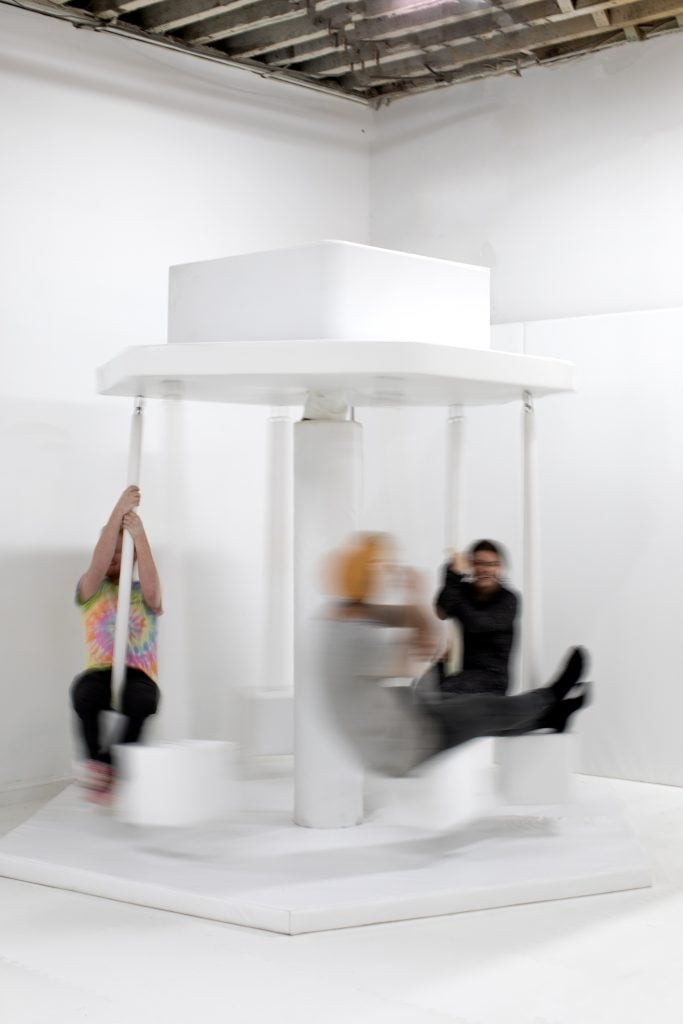
“Cj Hendry: Plaid” installation view. Photo courtesy of the artist.
“We talk to museums fairly regularly. But there’s always a long lead time. It’s years and years for them to plan. I’d have to leave that idea for three years and move on with others—my practice moves far quicker than that,” Hendry said. “The next logical step is to be represented by a gallery.”
That also might simplify the logistics of staging ambitious installations like “Plaid.”
“It would be really interesting to work with a gallery,” Hendry said. “They might go, ‘we’ll just build the thing, who cares?'”
“Cj Hendry: Plaid” is on view at 220 Newel Street Greenpoint, Brooklyn, April 14–23, 2023. Timed tickets are sold out through April 16, and entry is first come, first served for the rest of the run of show.
